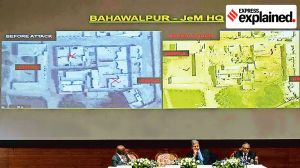Over 100 slums, farmhouses in the way of protecting Delhi Ridge
A senior official of the Forest Department said that the JJ clusters are likely to be removed as per availability of security and “the situation on ground”, since the notification of forest land is being done as per the orders of the National Green Tribunal (NGT).
 Parts of the Ridge that were not notified earlier are now being notified under section 20 of the Indian Forest Act, 1927. (File)
Parts of the Ridge that were not notified earlier are now being notified under section 20 of the Indian Forest Act, 1927. (File) Freeing the Ridge, that is what has been identified as forest land, of encroachments in the form of 103 JJ clusters as well as farmhouses is proving to be a tall order for authorities in Delhi.
A senior official of the Forest Department said that the JJ clusters are likely to be removed as per availability of security and “the situation on ground”, since the notification of forest land is being done as per the orders of the National Green Tribunal (NGT).
Parts of the Ridge that were not notified earlier are now being notified under Section 20 of the Indian Forest Act, 1927. As per the Act, notification of the land as ‘reserved forest’ means no rights can be acquired over the land, unless it is “under a grant or contract in writing made or entered into by or on behalf of the government”. It also prohibits clearing of land for cultivation or any other purpose, except in accordance with rules made by the State government in the matter.
The Forest Department official pointed out that the NGT, in an order issued in January 2021, had asked the Delhi government to notify the “area over which there is no controversy” within three months. The remaining area was to be identified and an action plan to remove the encroachments was to be ensured within the next three months.
As per minutes of the meeting last October of the oversight committee, which is monitoring the progress with regard to removal of encroachments from the Ridge, there are 103 JJ clusters located on land identified as forest land on the ridge or the ‘morphological ridge’. This is out of the DUSIB’s list of around 757 JJ clusters.
In the Rangpuri forest division, residents of JJ clusters had approached the Environment Minister over removal of encroachment from forest land, and the Forest Department had then decided to take a legal opinion on rehabilitation of eligible residents.
According to the Delhi Slum and Jhuggi Jhopri Rehabilitation and Relocation policy, JJ bastis that have come up before 2006 cannot be removed without providing alternate housing. The policy also states that land-owning agencies will not demolish a basti eligible for rehabilitation unless there is a court order.
Going by the minutes of the meeting, the Forest Department had intended to seek legal opinion on whether the JJ cluster rehabilitation policy overrides directions of the court for removal of encroachment and if the department should start demolition of bastis irrespective of its qualification for rehabilitation under the policy.
The forest department official said technically, the department does not have any provision of waiting for rehabilitation. The official added that removal of encroachments, notification of the Ridge, and possible rehabilitation is a continuous effort. Rehabilita-tion would be DUSIB’s mandate.
In some cases, notification of parts of the Ridge have also been held up by court orders that have called for status quo to be maintained. In an order from last October for instance, the Delhi High Court had ordered that status quo be maintained in the case of a farmhouse. The owner of a farmhouse in Asola village had approached the court stating that the Forest Department had demolished a part of the boundary wall without serving a notice. The Forest Department had submitted then that the petitioner had encroached on government property. The court had directed the petitioner to file a representation and the authority concerned was to hear and dispose of it preferably within eight weeks. The parties were then directed to maintain status quo till the decision on the representation.












